Gluten-Free Bagels
These Gluten-Free Bagels taste just like the ones from the bagel shop! These homemade gluten-free bagels are fluffy, tender, and perfectly chewy. Making bagels from scratch means you can customize with all of your favorites toppings! Store extras in the freezer to have bagels whenever you want. They’re vegan, too!
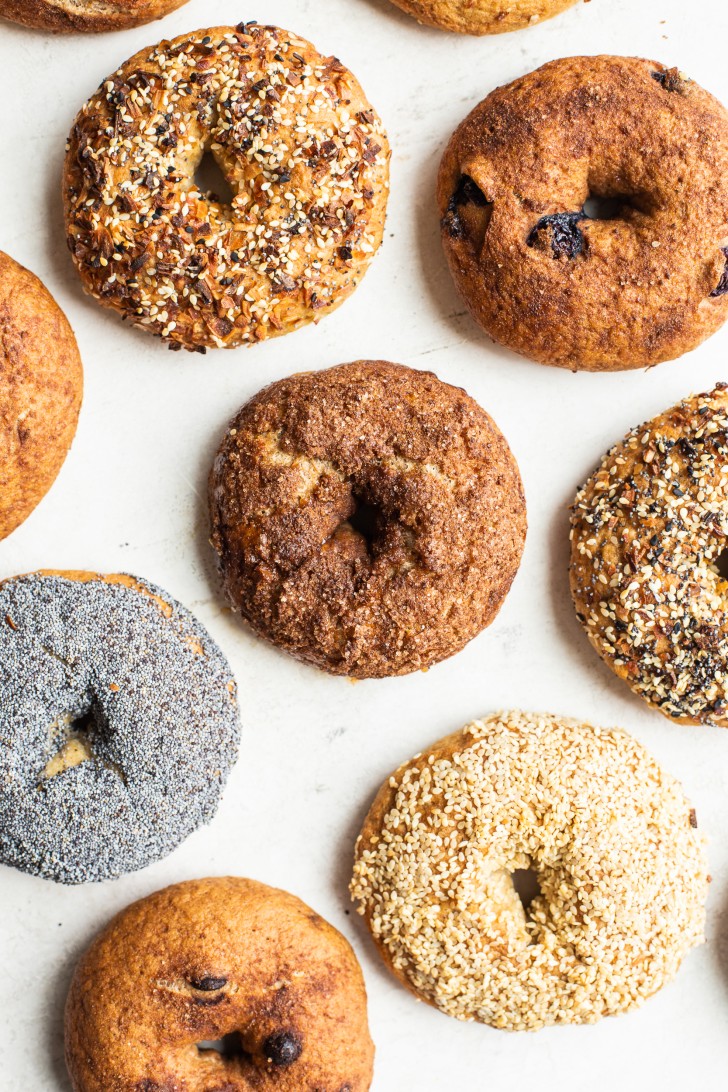
Welcome to gluten-free bagel wonderland! I’ve been making these on repeat recently, and I’m not getting sick of them. The flavor options are endless, and there’s nothing quite like a homemade bagel fresh out of the oven.
I recently posted this recipe for Gluten-Free Sourdough Bagels, but I know not everyone has or wants to maintain a sourdough starter. I also recently shared this super popular Homemade Gluten-Free Bread, and I knew I needed to marry the two recipes to create some kick-ass Gluten-Free Bagels, no sourdough starter necessary.
If you’d rather use your sourdough starter for bagels, pop over to that recipe for some amazing sourdough bagels.
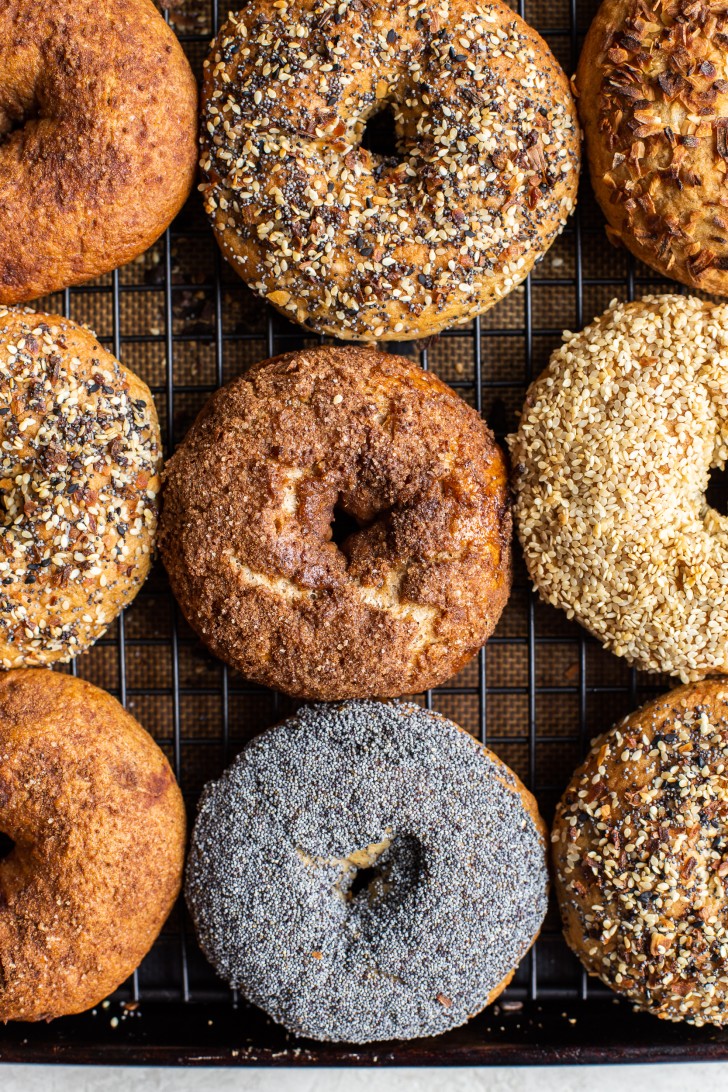
These gluten-free bagels are…
- Perfectly baked and chewy on the outside
- Soft, tender crumb on the inside
- The perfect canvas for adding your favorite toppings
- Easy to make in a few hours
- Dairy-free & vegan
- Freeze so well so you can have bagels on demand!
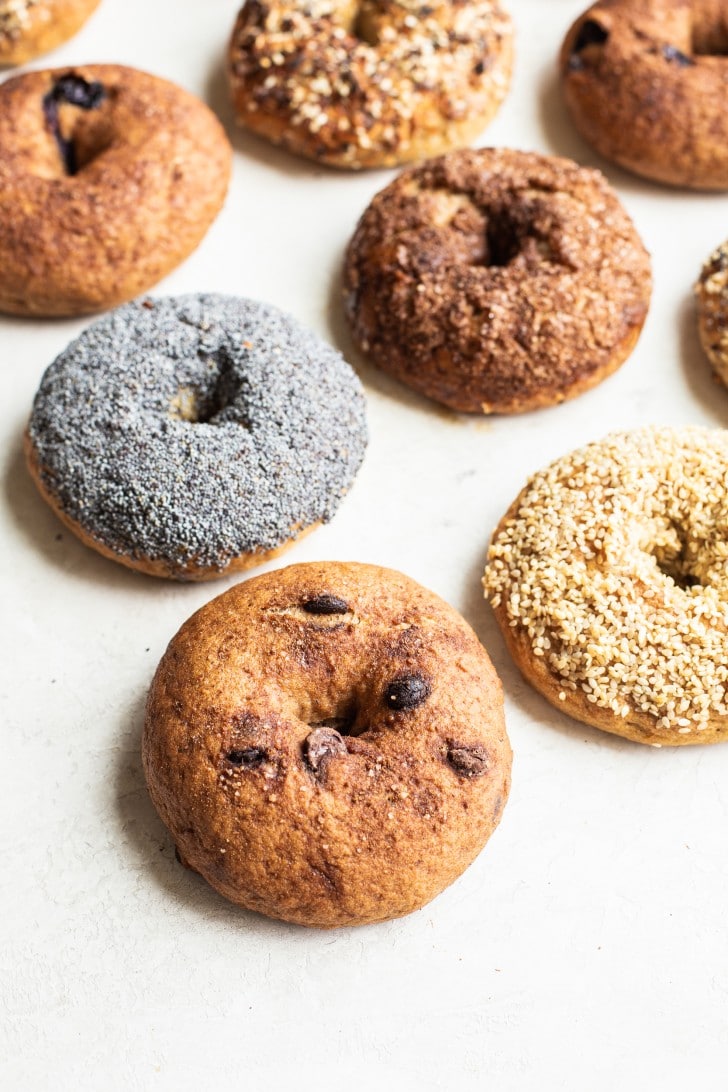
Why do you boil bagels?
These gluten-free bagels are just like traditional bagels in that they need to be boiled before they are baked!
We boil the bagels in a baking soda bath, which alkalizes the water and helps increase the Maillard reaction. A Maillard reaction is what promotes browning and caramelization in the oven. A sugar, like honey or molasses, can also be used in the water mixture, and molasses is commonly used instead of baking soda. The sugars in molasses similarly help brown the bagels when they’re baked.
The boiling also helps develop that signature chewy bagel crust! Don’t skip it – the boiling is key to a traditional chewy bagel.
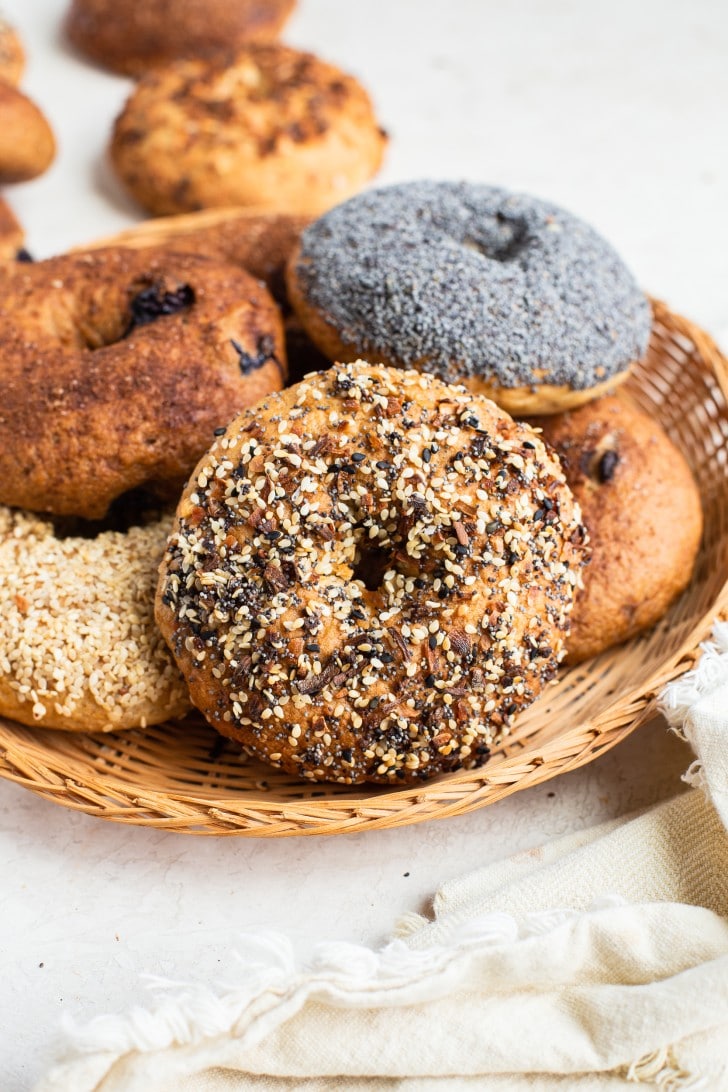
What bagel flavors can I make?
Really…the options are limitless! Use your creativity and you can recreate any of your favorite bagel flavors at home with this homemade gluten-free bagel recipe as the base. Here are some of the flavors that you see in the pictures, plus some other favorites.
Savory
- Everything
- Poppy Seed
- Sesame Seed
- Onion
- Cheese
- Jalapeno Cheddar
Sweet
- Cinnamon Sugar
- Blueberry
- Cinnamon Raisin
- Chocolate Chip
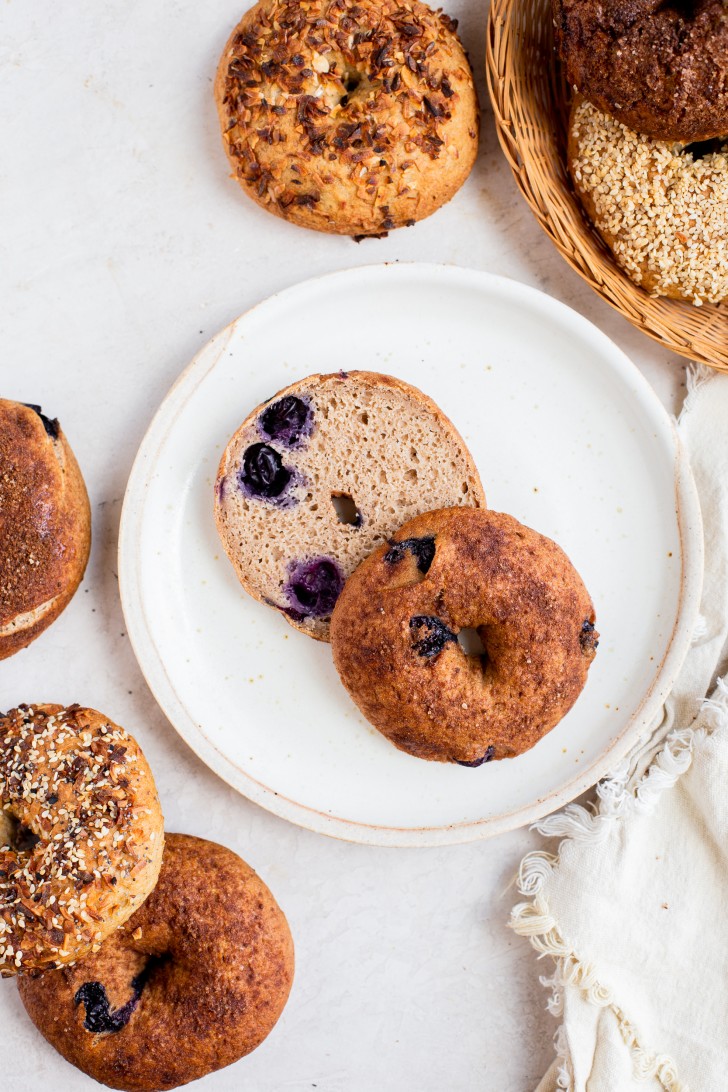
How to store gluten-free bagels:
To store, keep in an airtight bag or container for 2 to 3 days at room temperature. You can also slice them in half and store them in an airtight container in the freezer for up to 6 months.
Want more gluten-free bread recipes?
- Gluten-Free Sourdough Bagels
- Homemade Gluten-Free Bread
- Gluten-Free Sourdough Crackers
- Gluten-Free Sourdough Pizza Crust
- How to Make Gluten-Free Sourdough Bread
- Gluten-Free Sourdough Chocolate Chip Cookies
- Gluten-Free Sourdough Focaccia
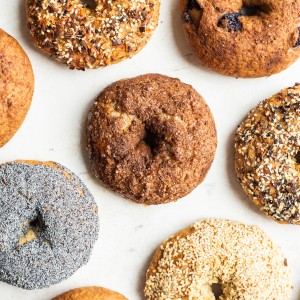
Gluten-Free Bagels
- Prep Time: 30 minutes
- Rise Time: 2 hours
- Cook Time: 30 minutes
- Total Time: 3 hours
- Yield: 8 bagels 1x
- Category: Bread
- Method: Baking
- Cuisine: American
- Diet: Gluten Free
Description
These Gluten-Free Bagels taste just like the ones from the bagel shop! These homemade gluten-free bagels are fluffy, tender, and perfectly chewy. Making bagels from scratch means you can customize with all of your favorites toppings! Store extras in the freezer to have bagels whenever you want. They’re vegan, too!
Note: I provide volume measurements for this recipe, but I really recommend using a kitchen scale if you have one. It makes gluten-free bread making so much easier and more accurate!
Ingredients
To activate the yeast
- 7g (2.5 tsp) active dry yeast
- ¼ cup + 3 tablespoons (100g) warm filtered water
-
1 tablespoon (20g) maple syrup, honey or cane sugar
For the loaf
- ¼ cup (20g) whole psyllium husk
- 1⅔ cup (375g) filtered water
- 1 tablespoons (15g) olive oil
- ½ cup (80g) potato starch
-
¼ cup + 2 tablespoons (60g) tapioca flour or arrowroot flour
- 1 cup (150g) sorghum flour
-
1 cup + 3 tablespoons (190g) brown rice flour
-
2 teaspoons (12g) sea salt
For the sweet version
- ¼ cup (45g) coconut sugar
- 1 teaspoon (3g) cinnamon
For the boiling mixture
- 1½ tablespoons baking soda
- 6 cups water
Instructions
-
In a small bowl, combine the yeast with the sweetener of your choice and warm water, between 100-110℉. It should feel warm, but not hot, to the touch. Let it sit to activate for about 10 to 15 minutes. You should notice it start to to bubble, and then it will get nice and foamy on top.
-
In a bowl or liquid measuring cup, mix together the psyllium husk, olive oil, and water. Whisk together, breaking up the psyllium, and let it set for a few minutes until it’s thickened and gel-like.
-
In a large mixing bowl or the bowl of your stand mixer, mix together all of your flours, starches, and salt. Whisk to combine. Also mix in the coconut sugar & cinnamon if you’ll be doing a sweet batch of bagels.
-
Add the psyllium gel and the activated yeast mixture to your dry ingredients. If using a stand mixer, fit it with the dough hook and let it mix up the dough until combined and smooth, scraping down the sides a few times during the process, and flipping the dough around to make sure it’s fully mixed on the bottom too. You can also do this process by hand. If doing it by hand, I like using a dough whisk to get it mostly combined, then, turn it out onto the countertop and use your hands to knead the dough and make sure all of the flour is incorporated.
-
If you’re adding in any mix-ins, like blueberries or chocolate chips, gently knead them into the dough now.
-
Bulk ferment the dough for 1 hour. I simply leave it in the mixing bowl, covered with a clean tea towel, to rise for one hour in a warm place. You should notice that the dough will just about double in size during the hour, and become nice and puffy.
-
Punch down the dough to release the air bubbles, and then divide the dough into 8 equal pieces (approximately 122g each) and shape each piece into a bagel. I like to do this by rolling into a ball and then using my thumb to press a hole in the center, and then open the hole a bit more with my fingers. You can also roll the dough into a long piece and then seal the ends together.
-
Place the bagels on a lined baking sheet and cover with a clean tea towel; let rise for 30 minutes to 1 hour or until slightly more puffy – you don’t want these to overproof so watch them carefully.
-
While the bagels rise, preheat the oven to 425℉ and get a big pot of water boiling.
-
When the bagels have puffed up, add the baking soda to the boiling water and boil the bagels 1 or 2 at a time, depending on the size of your pot, for 30 seconds on each side. I use a spider to place the bagels in the water and remove them, as it allows excess water to drip off easily. Remove from the pot, letting the excess water drip off as much as possible, and place back down gently on the baking sheet.
-
Repeat for all bagels and add any toppings, like everything bagel seasoning, cinnamon sugar, or other seeds of your choice. Immediately place into the preheated oven.
-
Bake for 30 minutes or until golden brown on top and crisp on the bottom.
-
To store, keep in an airtight bag or container for up to 3 days at room temperature. You can also slice them in half and store them in an airtight container in the freezer for up to 6 months.


Wow it a smart recipe! I cannot wait to try it.
Wondering the portions for add ins? Also blueberries fresh or dried?
I did fresh blueberries! I didn’t do the whole batch with each mix-in, so I don’t have specific proportions for those, and it kind of depends on preference as to how “loaded” you want them as well.
Thank you so much! They are delicous, I have made them several times now. Especially sugar and cinnamon, we love them, so tasty when soked through the next day.
So happy to hear that!! Thanks so much for the feedback.
Oops – forgot to leave stars!! Five star recipe :D
I made these with 1/2 cup added blueberries! We used small fresh blueberries. They turned out perfect. So fluffy and delicious with burst of blue. They were so pretty too! Going to try the savory versions next. Thank you!!!
Yum so happy you loved them – blueberry bagels are just too good!
Wow these are Amazing!! So happy I tried these. Cannot be more grateful for your recipes:)
So glad you’re loving them!!
Hi! Any suggestions to replace sorghum flour, our son has a sensitivity to it. I hope to make these as the ones I have found in store have rice flour, which he also has a sensitivity to.
Hi Samantha! Millet flour, oat flour, buckwheat flour, teff flour, and quinoa flour should all work – quinoa, teff, and buckwheat can have a slightly strong flavor though. Millet or oat is your best best for a mild flavor! Enjoy :)
Hello Rachel, I purchased all of the different flours and now realize I am not sure how to substitute them. For example, if I substitute oat flour for rice flour, do I use the same amount? For the Sorghum I will substitute millet flour, do I also use the same measurements for this? I also plan to make the raisin bread so I’m hoping you can help me figure this out. Thank you so much!
Hi Samantha, yes you’ll want to keep the amounts the same when substituting out the flours :) enjoy!
It looks like you previously answered my question, sorry about the repeat :)
If I want to use white rice flour instead of brown rice flour, would the amount be the same? I really want to try this recipe but only have white rice flour :) Thank you
Yes, the amount would stay the same! Enjoy :)
Can I replace brown rice flour with millet flour and sorghum flour with oat flour as the exact substitution? Or do I need to measure them differently? I am attempting these recipes, but our son has an allergy to rice and sorghum. Thank you so much in advance.
Hi Samantha, yes that should be just fine — use them in equal amounts.
Hey Rachel! I’m making these for the first time now and I’m so excited because I love your sourdough recipes! In step 5, you mention kneading “the rest of the flour in”. But where is that listed? How much of the flour mixture should I set aside?
Hi Brenna! All I mean there is to make sure to incorporate all of the flour, since sometimes it gets stuck to the bottom of the bowl, etc. Sorry that the way I worded it is confusing! No flour should be set aside.
Hey Rachel, I see that you changed it up and think it’s definitely more clear. Thanks for this recipe! I really love the way they turned out. I did 4 cinnamon sugar and 4 everything and they’re amazing.
Wonderful, glad to hear that!! I’m so thrilled you’re loving them :) Thanks for the feedback!
Do you think it would work if I let the dough bulk ferment in the bowl overnight? This way when I wake up I can finish off the recipe and have them fresh in the morning. What do you think?
Hi Crystal, yes for sure! Just let the dough rise in the fridge to slow it down. It will help develop the flavor as well :)
I have made these so many times now, this is the best recipe for gluten free bagels!! Thank you so much!
So glad you’re loving them, Helena!
I can’t decide which of your bagel recipes to make first. Others have described these bagels as fluffy, which is not how I think of bagels. Having lived in NYC, I learned the difference between a bagel and a bagel. Your gluten free, sourdough bread recipe comes out perfect every time. Which of your two bagel recipes would you say is most like a New York Bagel.
Thank you
Hi Jo, they’re pretty similar, it just depends on whether you want to use sourdough or not! My grandma’s family owned a NYC bagel shop when she was growing up and she gave rave reviews to both :) it’s been a while since I had a traditional NYC bagel, so unfortunately I can’t give a super accurate recommendation as to which would come closer.
These bagels made my day. My husband declares these 5 star and better than the bagel shop bagels we used to buy in our pre gluten free days.
So glad you and your family are loving them, Earlene! It’s super helpful if you could add a star rating next time, too :)
I didnt see the star rating and wanted to make sure everyone knows that the bagesl are 5 star!
Thanks so much, Earlene!
Hi there! I want to try this recipe w/o buying all the flours separately. Can I use Bob’s red mill 1 to 1? It has all the flours mixed in but not sure of how much to use or if it would even work. Thanks much! Also I do have cassava, oat flour, and tapioca that I can use as well. Thanks!
Hi Kori, I wouldn’t recommend 1:1 flours because they generally have gums added, which affects the texture of the recipe. I do have my own gluten-free flour blend that I recommend if you want to streamline things. Cassava tends to be extra absorbent so it doesn’t always work as a 1:1 grain-flour replacement in my recipes, but oat flour does. If you’re set on buying a flour blend, I recommend this one from Vitacost – the ingredients are very similar to what I use in my breads and I’ve tested it many times with success.
These sound delicious. Can I substitute psyllium husk powder for the whole husk? And how much would I use please?
Hi Liana, to substitute psyllium husk powder, you’ll want to use about 75% of the amount called for – for this recipe it would be 15g. You’ll also want to mix it with the dry ingredients instead of the liquid so it doesn’t clump, and let the dough rest for a bit to help it hydrate. Hope this helps!
I am a little confused, how much water am I adding to the psyllium husk?
Hi Sarah, the water measurement is listed right below the psyllium husk in the ingredients list – 375g.
When i make this recipe, can I use your flour blend and if so how much do n total would i use?
Yes you can, you use the total amount of flours + starches the recipe calls for.
I love these bagels!! I want to try the cinnamon raisin. Do you soak the raisins first before adding them to the dough before the bulk ferment?
Thanks!
You can soak if they’re super dry, or if they’re already soft/plump, there’s no need to!
Excellent bagels and I seeded with Everything Bagel seasoning. Makes my one chilf who is GF extremely happy… and he loves the GF bread recipe as well.
So glad you’re loving it, Olivia!
Do you recommend cooling the bagels completely after baking before cutting into them? I follow that suggestion with your your bread recipe and it makes a huge difference, but maybe these don’t need that step? So happy to have found your recipes!
Hi Courtney, with the smaller breads I usually tear into one to eat it warm and it doesn’t seem to make as big as an impact with rolls/bagels as it does with the big loaves. I wouldn’t slice them all warm or anything but if you want to enjoy some warm bread, it won’t be super gummy or anything if you do. Enjoy and happy baking!